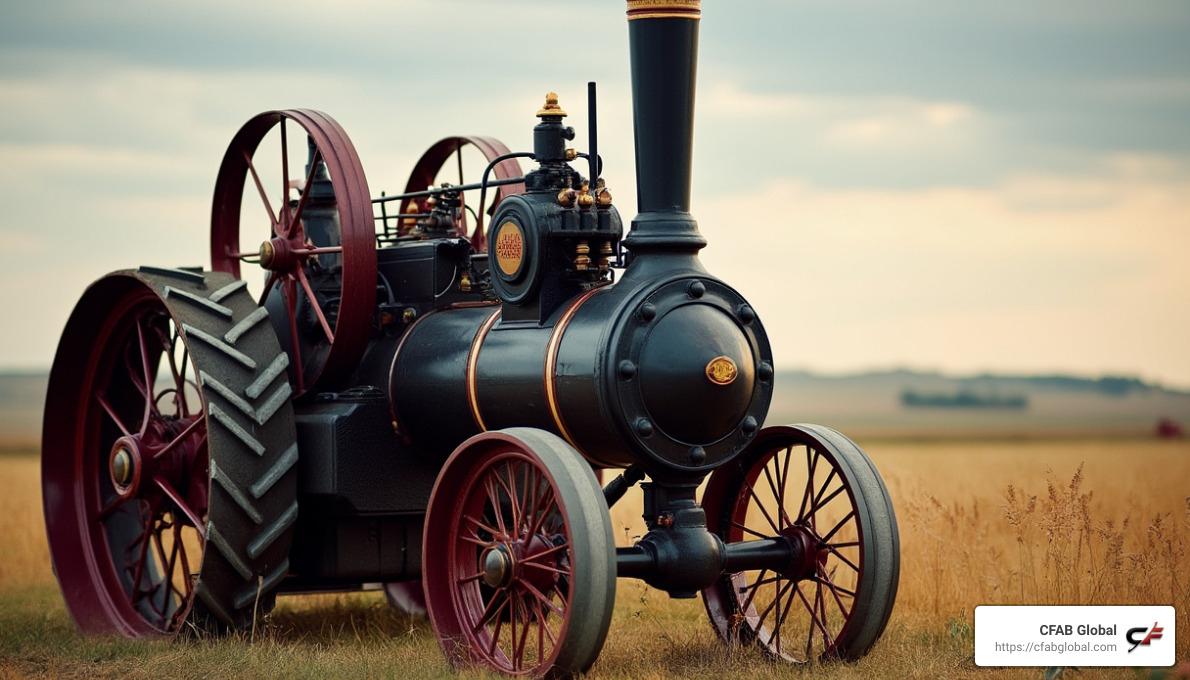Antique agricultural equipment marks a fascinating journey that begins with the Neolithic Revolution, a transformative era when humans first acceptd settled farming. During this time, simple tools crafted from wood, stone, and bone enabled early farmers to cultivate the land, setting the foundation for agricultural development that would shape human civilization.
- Neolithic Revolution: A pivotal turning point in human history, marking the transition from nomadic lifestyles to the establishment of permanent settlements.
- Settled Farming: The emergence of agriculture as people began to grow crops and raise animals, leading to the growth of communities and the development of technology.
- Simple Tools: Basic implements, including hand tools and animal-powered devices, made from readily available materials, laying the groundwork for future agricultural innovation.
As we dig into antique agricultural equipment, we explore a rich mix of history and innovation. Through their resilience and ingenuity, these early tools paved the way for the sophisticated machinery that fuels modern agriculture today.
I’m Todd Cleppe, with over 25 years of experience in engineering and manufacturing, focusing on enhancing machinery efficiency across various industries. Having worked on improving food processing equipment and automated lubrication systems, my background ties closely with the evolution of machinery—from antique agricultural equipment to modern marvels. Let’s journey further into the fascinating world of these historical tools and their lasting impact.

Evolution of Agricultural Equipment
The story of agricultural equipment is a testament to human ingenuity and adaptation, starting from the most basic tools and culminating in the complex machinery we see today.
Early Implements: Wood, Stone, and Bone
In the earliest days of agriculture, humans relied on the natural materials available to them. Wood, stone, and bone were the primary resources used to create rudimentary tools. These materials were crafted into simple implements like hoes and sickles, which were essential for planting and harvesting crops.
- Wood: Versatile and widely available, used for handles and basic structures.
- Stone: Shaped into sharp edges for cutting and grinding.
- Bone: Used for finer tasks, like sewing or detailed carving.
These tools were the backbone of early farming, enabling the first agricultural communities to thrive.
The 1800s: A Century of Innovation
The 19th century brought significant advancements in agricultural technology. This era saw the development of more sophisticated machinery, which dramatically increased farming efficiency and productivity.
-
Horse-Drawn Equipment: Before the advent of engines, horses were vital for pulling plows and other heavy implements. This mechanization allowed for larger fields and increased yield.
-
Mechanical Reapers and Threshers: These innovations revolutionized the way crops were harvested, reducing the time and labor needed for these tasks.
The Steam Engine Revolution
The introduction of steam engines in the late 1800s marked a turning point in agricultural machinery. These powerful machines could perform tasks that were once unimaginable with animal or human labor alone.
-
Steam-Powered Tractors: These early tractors could plow fields much faster and more efficiently than horses, paving the way for modern farming practices.
-
Threshing Machines: Steam engines powered large threshers, which separated grain from stalks, further reducing manual labor and increasing productivity.

The evolution from simple tools to steam-powered machinery laid the groundwork for the technological advancements that would follow. Each step in this journey reflects a leap in human capability and the relentless pursuit of efficiency in agriculture.
As we continue to explore the history of antique agricultural equipment, we uncover the innovations that have shaped farming practices throughout the ages. These developments not only improved productivity but also transformed the agricultural landscape, setting the stage for the modern era.
Common Antique Farm Tools
Before the age of modern machinery, farmers relied heavily on hand-operated tools, oxen plows, and horse-drawn equipment to cultivate their land. These tools were the backbone of agriculture, shaping the way food was produced and communities were sustained.
Hand-Operated Tools
Hand-operated tools were essential in early farming. Simple yet effective, these tools were crafted from materials like wood and metal.
-
Scythes and Sickles: Used for harvesting crops, these tools required skill and strength. A well-made scythe could cut through fields of wheat with a rhythmic motion.
-
Hoes and Rakes: These tools were vital for preparing the soil and removing weeds. They allowed farmers to maintain their fields with precision.
-
Manual Drills: Before the advent of powered equipment, hand-operated drills were used to plant seeds, ensuring they were placed at the right depth and spacing.
These tools were often passed down through generations, each bearing the marks of years of labor and care.
Oxen Plows
The oxen plow was a significant advancement in farming technology. Before tractors, oxen were the primary source of power on the farm.
-
Single Blade Plows: These were used to break up the soil, making it easier to plant seeds. The strength of the oxen allowed farmers to plow larger areas than they could by hand.
-
Double Blade Plows: As farming techniques improved, double blade plows were introduced to turn the soil more effectively, increasing aeration and promoting better crop growth.
Oxen plows were not only practical but also a symbol of farming tradition, representing the bond between farmer and animal.
Horse-Drawn Equipment
Horses played a crucial role in farming before the mechanization of agriculture. They were faster and more agile than oxen, making them ideal for pulling various types of equipment.
-
Horse-Drawn Plows: These plows were lighter and could be maneuvered more easily, allowing for more precise farming.
-
Wagons and Carts: Used for transporting goods, these vehicles were essential for moving crops from the field to storage or market.
-
Seed Drills and Harrows: Horse-drawn versions of these tools allowed for more efficient planting and soil preparation, leading to better yields.
The use of horses in farming required skill and care, as maintaining the animals’ health was crucial for a successful harvest.
The legacy of these antique agricultural tools is still evident today, as they laid the foundation for the sophisticated machinery we now use. Each tool tells a story of innovation and adaptation, reflecting the hard work and ingenuity of farmers throughout history. As we dig deeper into the evolution of farming equipment, we uncover the rich mix of agricultural heritage that continues to influence modern practices.
Antique Agricultural Equipment
In the heart of regions where traditional farming thrives, such as the Mennonite communities, antique agricultural equipment exemplifies a unique blend of tradition and innovation. These farmers have transformed challenging lands into fertile fields, often relying on tools and techniques passed down through generations.
Mennonite Farming Traditions
The Mennonites, known for their simple way of life, have been farming for over a century. Their commitment to traditional farming methods is evident in their choice of equipment. Many Mennonites prefer antique farm equipment, which aligns with their values of self-reliance and sustainability. This includes tools like hand-operated plows and horse-drawn carts, which are still used to cultivate crops such as corn and chili peppers.
Living in brick houses that they build themselves, Mennonites create a self-sustained community. These homes are typically simple, often consisting of one large room that serves multiple purposes. The use of brick, a material known for its durability and insulating properties, reflects their practical approach to both farming and living.
The Role of Antique Equipment
The use of antique equipment is not just about tradition; it’s also about practicality. For the Mennonites, these tools are reliable and require minimal maintenance compared to modern machinery. They are adept at repairing and maintaining their equipment, ensuring it lasts for decades. This skill is crucial, especially in an environment where resources can be scarce.
-
Horse-Drawn Plows: These plows are still a common sight in Mennonite fields. They are valued for their ability to work the land without the need for fuel, making them both economical and environmentally friendly.
-
Manual Seed Drills: By using hand-operated seed drills, Mennonites can control the planting process with precision, ensuring each seed is placed at the optimal depth and spacing for growth.
-
Simple Harvesting Tools: Scythes and sickles are used for harvesting, requiring skill and physical strength. These tools have been honed over generations, each bearing the marks of countless harvests.
The Mennonites’ approach to farming with antique agricultural equipment is a testament to their resilience and adaptability. While modern technology encroaches on their traditional ways, they continue to thrive by balancing innovation with tradition. This blend of old and new not only sustains their community but also preserves a rich agricultural heritage that offers valuable lessons for sustainable farming practices today.
The Role of Tractors in Farming History
Tractors have played a pivotal role in changing agriculture. Before their invention, farming was labor-intensive, relying heavily on manual labor and animal power. However, the introduction of tractors revolutionized this process, making farming more efficient and less physically demanding.
The Rise of Tractors
The first tractors appeared in the late 19th century and were initially steam-powered. These early models were cumbersome and not widely adopted. It wasn’t until the development of gasoline and diesel-powered tractors in the early 20th century that they became practical for widespread use.
-
Efficiency: Tractors allowed farmers to cultivate larger areas of land more quickly than ever before. This increased efficiency led to higher crop yields and the ability to feed more people.
-
Versatility: Tractors are highly versatile, capable of pulling plows, harrows, and other equipment. This adaptability made them an indispensable tool on farms.
Antique Tractors and the 1960 Rule
Antique tractors hold a special place in farming history. These machines, often built before the 1960s, are revered for their engineering and design.
The 1960 rule is a common guideline used to classify a tractor as antique. According to this rule, a tractor must be at least 30 years old to be considered antique. This classification is important for collectors and enthusiasts who preserve these machines for historical and educational purposes.
-
Preservation: Many farmers and collectors restore antique tractors, showcasing them at fairs and exhibitions. This preservation effort keeps the history of agricultural innovation alive.
-
Mechanical Simplicity: Antique tractors are known for their mechanical simplicity. Unlike modern tractors, they often lack complex electronic systems, making them easier to maintain and repair.
Impact on Modern Farming
While modern tractors are equipped with advanced technology, the legacy of antique tractors continues to influence farming practices. They serve as a reminder of the progress made in agriculture and the importance of innovation in meeting the demands of a growing population.
Tractors, both antique and modern, have undeniably shaped the landscape of agriculture. Their introduction marked a turning point, leading to the efficient and productive farming methods we see today. As we continue to advance, the lessons learned from these pioneering machines remain relevant, guiding sustainable and innovative farming practices.
Frequently Asked Questions about Antique Agricultural Equipment
What is the oldest agriculture equipment?
The journey of antique agricultural equipment begins with the earliest tools used by humans. During the Neolithic era, people transitioned from a nomadic lifestyle to settled farming. This shift brought about the creation of simple tools made from wood, stone, and bone. These early implements, such as hand-held hoes and plows, were crucial for cultivating the land and are some of the oldest agricultural tools known to humanity.
What equipment did farmers use in the 1800s?
The 1800s marked significant advancements in farming technology. Farmers relied on a combination of hand tools and animal power to work the fields. Hand tools like scythes and sickles were essential for harvesting crops. Oxen and horses were commonly used to pull plows and carts, making it easier to till large areas of land.
The latter part of the century saw the introduction of steam engines, which revolutionized farming. These engines powered threshing machines and other equipment, reducing the reliance on manual labor and animal power. This period laid the groundwork for the mechanization of agriculture, paving the way for the modern machinery we use today.
What is considered an antique tractor?
In agricultural machinery, the classification of a tractor as “antique” is governed by the 1960 rule. According to this guideline, a tractor must be at least 30 years old to be considered an antique. This means that any tractor built before 1960 fits this category.
Antique tractors are cherished by collectors and enthusiasts for their historical value and engineering marvels. These machines, often less complex than their modern counterparts, showcase the ingenuity of early tractor design. They are celebrated for their mechanical simplicity, which makes them easier to maintain and repair. Enthusiasts often restore these tractors, displaying them at fairs and exhibitions to preserve the history of agricultural innovation.
Antique tractors and equipment not only highlight the evolution of farming but also serve as a testament to the enduring spirit of innovation that continues to drive the agricultural industry forward.
Conclusion
As we reflect on the journey of antique agricultural equipment, it’s clear that these tools have played a pivotal role in shaping the farming practices we know today. From the early days of simple hand tools to the development of steam-powered machinery, each innovation has paved the way for modern agriculture.
At CFAB Global, we understand the importance of operational efficiency in agriculture. Our commitment to enhancing machinery performance is exemplified through our exclusive Machine Reliability Program. This program is custom to meet the unique needs of each client, ensuring that their equipment operates at peak performance. By providing personalized analysis and cutting-edge services, we help businesses maximize productivity and reduce costly downtime.
Our expertise in machinery solutions extends beyond just maintaining equipment. We strive to build lasting relationships with our clients, supporting them every step of the way. Whether you’re dealing with antique machinery or the latest technology, CFAB Global is your trusted partner in achieving operational excellence.
For those interested in exploring how CFAB Global can support your agricultural needs, visit our Agricultural Equipment page to learn more about our services and how we can help boost your farm’s efficiency.
When the past meets the future, CFAB Global stands at the forefront, ensuring that your machinery not only withstands the test of time but thrives in it.






